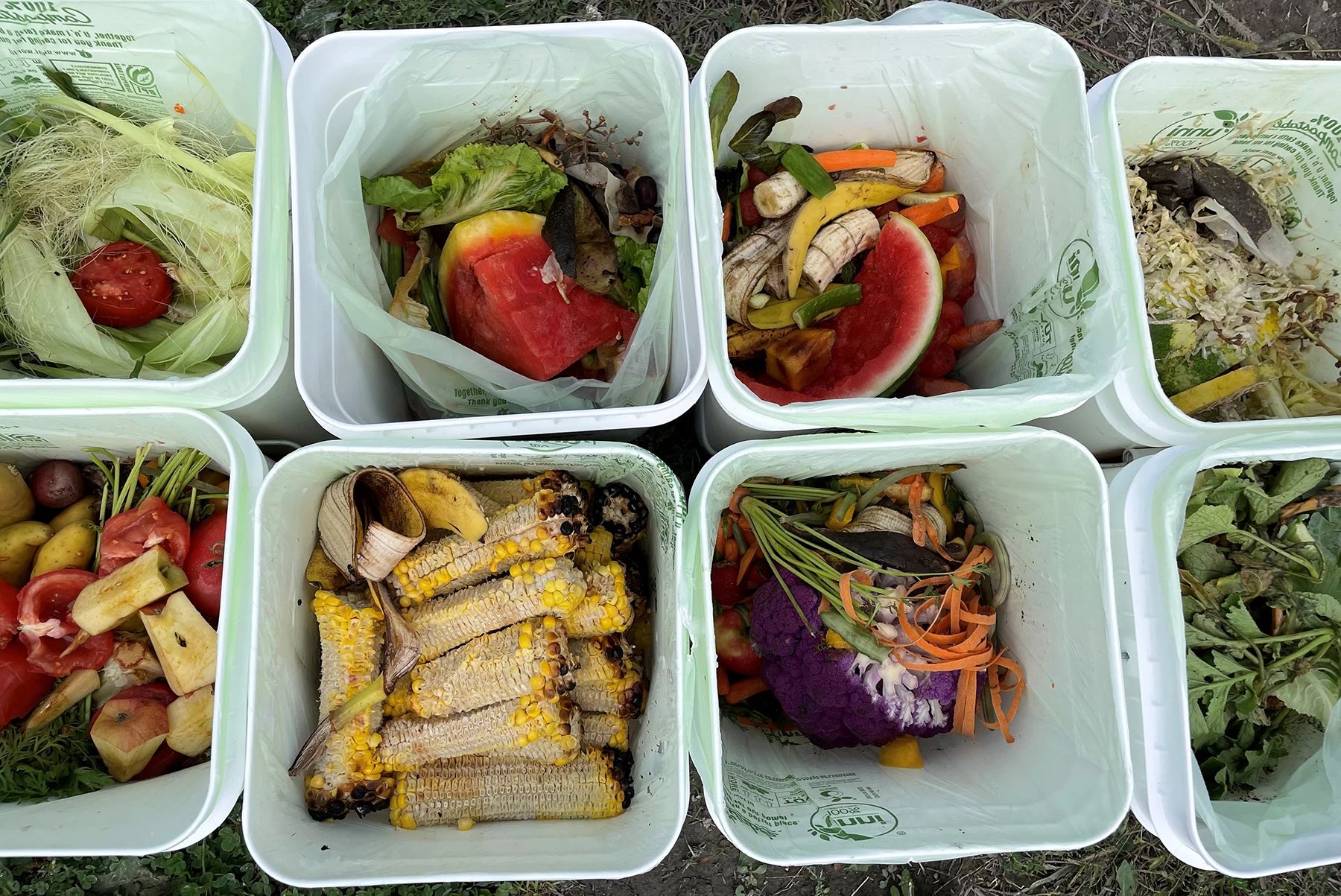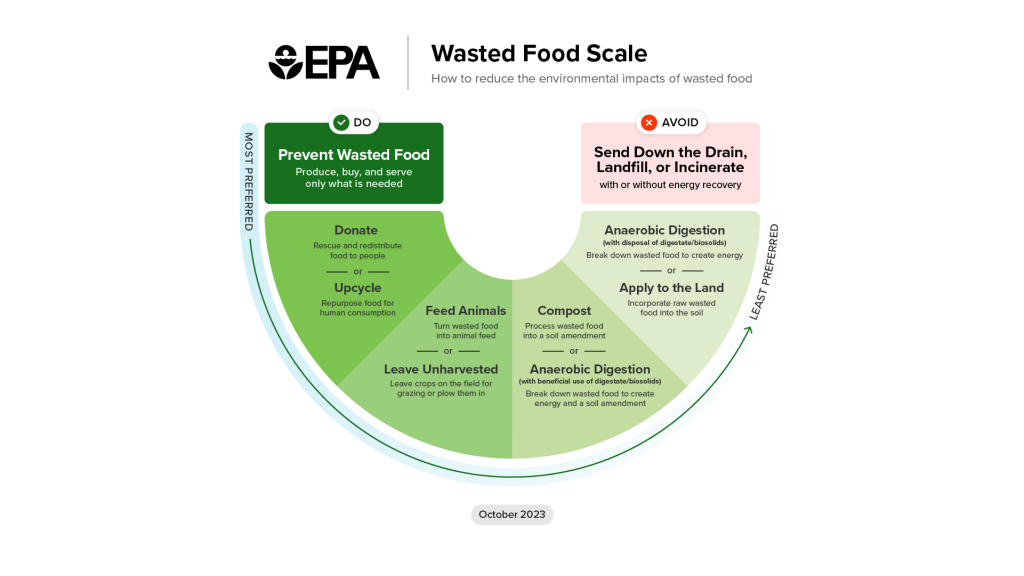Reducing Food Waste at Home

Buckets of food waste and scraps for composting. Photo Credit: DNR
Food waste and scraps make up the largest part of trash in Wisconsin landfills. When food goes in the trash, so do resources, time and money.
Reducing food waste helps save resources used to produce, store and distribute the food. It also cuts greenhouse gas emissions from food decomposing in landfills.
The Department of Natural Resources' (DNR) 2020-2021 Statewide Waste Characterization Study found that food waste made up 20% of trash going to Wisconsin landfills. This amounts to approximately 854,000 tons annually, or 294 pounds per person in Wisconsin during the study period. The study estimated that more than three-quarters of this food could have been consumed by people.
- Wisconsin's 2020-2021 Waste Characterization Study Reports and Images
- What is Ending Up in Wisconsin Landfills? Infographic
Prevention Has The Most Impact
Preventing food waste is easy and powerful. You reduce greenhouse gas emissions and save natural resources. Plus, it can save you money. The U.S. Environmental Protection Agency report Estimating the Cost of Food Waste to American Consumers estimated the amount of savings available to Americans by reducing food. The report estimated the cost of food waste to each U.S. consumer to be $728 per year. For a household of four, the annual cost is $2,913, with an average weekly cost of $56. Check out the following actions to reduce food waste at home.
Shopping With A Plan And Preparing For Gatherings
Tips For Routine Meal Planning
Purchasing more food than what is needed often leads to more food waste.
- Take inventory: See what food you already have at home, what needs to be used soon and how much space you have for new items.
- Plan meals: Use online tools to figure out how much of each ingredient to buy based on the number of servings you need.
- Make a list: Save time and reduce impulse buys by skipping aisles with unwanted items.
- Eat before shopping: Hungry shoppers are more likely to make extra purchases. This goes for kids, too!
- Deal-breaker: Buying in bulk is worth it only if you can use all the food in a timely manner.
- Track the excess: After a few grocery trips, take note of what goes uneaten and cut back on buying those items.
Tips For Gatherings
- Get a headcount: Use online calculators to determine how much food you need to prepare. Create a menu that accommodates dietary restrictions rather than making extra alternatives. Save The Food's Guest-Imator can help.
- Build a buffet: To avoid overserving, let guests serve themselves on their own plates. Making pre-cut foods mini can also help guests grab the right portion.
- Fill when empty: Open extra packaged food only if the first round has run out.
- Potluck partnership: If guests are contributing to the meal, explain how they can also help reduce waste.
- Store and share: Put leftovers in containers to eat later or send them home with guests who want them. If you have lots of extras, consider sharing with the neighborhood or office or donating the leftovers.
Storing Food To Extend Its Life
Storage Tips
- Storing food properly can reduce food waste and save the time and money associated with additional grocery store runs. Save the Food's Store It guide is interactive. It offers tips, tricks and info to keep your food fresh longer. Save the Food's Store It Guide
The USDA's FoodKeeper app also offers specific storage timelines. It covers the refrigerator, freezer and pantry for both opened and unopened food items.
Below are some more general rules to keep in mind. Remember to hold off on washing produce before you store it.
Location
Food Items
A cool, dry, dark place Garlic, onions, potatoes, sweet potatoes, winter squash The countertop until ripe; once ripe, place in the refrigerator Avocados, bananas, mangos, kiwis, peaches, pears, melons, oranges, tomatoes The refrigerator in a container with vents that allow moisture to escape Berries, cherries, grapes The refrigerator in a paper bag to absorb moisture Mushrooms The refrigerator in a high-humidity crisper drawer to slow wilting Beans, beets, broccoli, Brussels sprouts, cabbage, carrots, celery, corn, cucumbers, eggplant, peas, peppers, zucchini The refrigerator in a drawer away from other produce to contain ethylene gas that speeds up ripening Apples, counter fruits moved to the refrigerator The refrigerator in an airtight container with damp towels Asparagus, herbs, leafy greens The freezer Nuts, seeds and any produce, meat, seafood, tempeh, tofu, seitan, bread, baked goods and herbs you do not plan to use quickly Additional Tips For Opened Items
- Store cupboard items in an airtight container if they typically turn stale before you can finish them. Clear containers and labels will help you keep track of the repackaged items.
- To extend the life of cheese blocks and other tightly wrapped items, keep them in their packaging. After opening, put them in an airtight container.
- Freeze what you can't use immediately. Once opened, many items, such as tomato sauce, pizza sauce, pesto, curry paste, tomato paste, broth, buns and baked goods, can be frozen.
- Dairy products and alternatives can be frozen without food safety concerns, but this may result in some changes in texture. Consider freezing leftover buttermilk, yogurt, coconut milk, nut milk and more until they are cooked, baked or blended.
- Color or color changes are not always an indication that meat is unsafe. Check for an off odor or change in texture to indicate spoilage. A meat thermometer is the best way to determine if food has been heated to a safe temperature. For more information, visit the U.S. Department of Agriculture's Color of Meat and Poultry webpage.
Using Recipe Generators And Ingredient Substitution Tools
Finding Recipes To Use Up Food
Recipe generators can be a big help when faced with leftovers, an abundance of garden goods or food that's about to spoil. Simply enter your ingredients (one or many), and it will generate recipes to help you use them. Search "recipe generator based on ingredients" to find some options.
Here are a few examples of free recipe generator websites and smartphone apps:
- Save the Food Recipes
- Foodcombo website
- MyFridgeFood website and app
- SuperCook website and app
- Tasty website
Several go-to recipes help use up foods before they go bad.
- Smoothies
- Omelets
- Stir-fries
- Pastas
- Soups, stews or chili
- Hot dishes or casseroles
Ingredient Substitution Tools
Ingredient swapping is a great way to repurpose food odds and ends and avoid being unable to finish a recipe due to missing a key ingredient. Search "ingredient swap" to find suitable substitutions. Allrecipes has compiled a comprehensive list of common ingredient substitutions.
A few common ingredient swaps include:
- Broth or apple cider vinegar for wine
- Milk and butter for heavy cream
- Lemon or lime juice for vinegar
- Applesauce for vegetable oil (in baking)
- Yogurt for sour cream (and vice versa)
Another swapping option is tweaking a recipe for your flavor preferences or with what you have on hand. You can swap various extracts when baking (vanilla, almond, orange, etc.), grains when coating or topping foods (breadcrumbs, crushed cereals, crackers or chips) or mix-ins when baking (dried fruit, nuts, candies and baking chips).
Understanding Date Labels And When Food Items Are Actually Unsafe
Confused by date labels on foods? What does it all mean?
One reason for food waste is when consumers or retailers throw away wholesome food because they are confused about the dates on the labels. Except for infant formula, dates do not reflect the product's safety and are not required by federal law. Manufacturers provide dates to help consumers and retailers decide when food is of the best quality.
The FDA advises consumers to examine foods to determine if the quality is sufficient for use. Trust your eyes and give the food an old-fashioned sniff test to tell you if it is still good. This can help you avoid throwing away healthy and safe food.
Diverting Food From Landfills
While preventing food from being wasted is the highest priority, some food waste is unavoidable. The U.S. EPA's Wasted Food Scale identifies five major destinations where food can be captured and used as a resource and not a waste.
Food Donation
Check with your local health department to find nearby food banks and hunger relief groups that accept donations. The Wisconsin Recycling Markets Directory lists food rescue organizations around the state. They are listed under the "Organic/Food Materials" category and the “Food Rescue” subcategory.
Food Donation Laws
Both state and federal laws protect food donors from liability. The federal 1996 Bill Emerson Good Samaritan Food Donation Act and the Food Donation Improvement Act of 2021 support donating food and groceries for distribution to those in need. The law protects donors from civil and criminal liability. If they donate a fit and wholesome product in good faith, they won't be held responsible if it later harms someone.
Wisconsin law, s. 895.51, Wis. Stats., also protects any person engaged in the processing, distribution or sale of food products, for-profit or not-for-profit, who donates or sells qualified food to a charitable organization or food distribution service. The person would be immune from civil liability for the death of or injury to any individual caused by the qualified food donated or sold by the person.
Composting Food
Composting food scraps and yard waste helps keep them out of landfills. When compost is used, it returns nutrients and carbon to the soil. The DNR has resources on backyard composting, compost subscriptions and drop-off locations.
Composting is a process that needs oxygen. It turns organic materials into a nutrient-rich soil amendment or mulch. This happens through natural decomposition and does generate a small amount of greenhouse gas. In a landfill, organic materials break down without oxygen. The bacteria in the landfill help decompose the materials and generate methane, a powerful greenhouse gas. Municipal solid waste landfills are the third largest source of human-related methane emissions in the United States. They made up about 14% of methane emissions in 2022. Wasted food causes 58% of the methane from these landfills.
Additional Resources
The U.S. EPA, USDA and FDA have several webpages and resources related to residential food waste.
- Preventing Wasted Food at Home
- The 2019 Wasted Food Report
- Estimating the Cost of Food Waste to American Consumers
- Food: Too Good to Waste
- USDA Food Loss & Waste – Consumers
- FDA Tips to Reduce Food Waste
- USDA's Frequently Asked Questions about the Bill Emerson Good Samaritan Food Donation Act
- USDA's Food Safety FoodKeeper App

